Faial

Tamarisk
Sat 17 Jun 2006 18:23
|
We have really enjoyed our week in Faial.
It's the most westerly of the central group of islands in the Azores. It's
quite small, just 22km by 15 km with a population of about 16,000. The
harbour in the capital, Horta, is heaving with transatlantic traffic at
this time of the year, we were told it's the fourth busiest for sailing boats in
the world. (After Chagaramus in Trinidad, Bermuda and
Gibraltar). As the weather has improved over the past few days more
and more have moved onto other islands in the Azores, or have begun the trip
back to Ireland, the UK or Portugal. In the background Mount Pico
rises up from the neigbouring island, it's quite a wonderful spot.
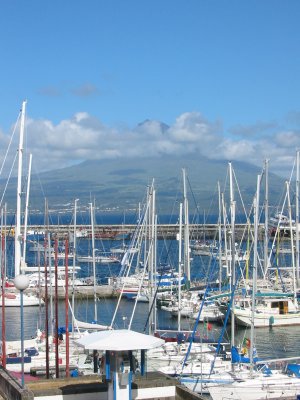 There's still room for the local fishing boats in
the habour, we were told this is the best place in the world to catch tuna and
blue marlin. We failed miserably to catch a single fish on the journey
here.
 Every inch of wall and pavement is covered in the
paintings left by cruisers ..Caroline and Anna worked on our 'til the last
day.
 Our mark
 We only had a day and half with John, Penny and
Nina before they flew on to Lisbon. We took full advantage of all their
hotel's facilities, here are the children enjoying the jacuzzi after the long
passage !
 Tim, Penny and John could hardly wait for their
first pint. This was Tim's "Ice Cold In Alex" moment in Peter's Sports
Bar. And yes he did drink another one straight away.
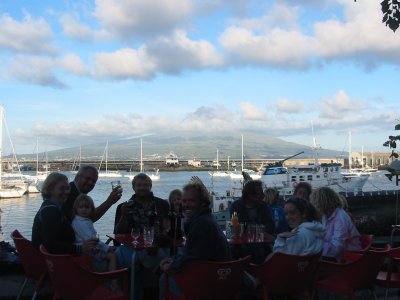 It didn't take long for the party to get
going, this was a few hours later with Penny, John and Nina, and the crews of
Blase and Odysseia outside Peter's.
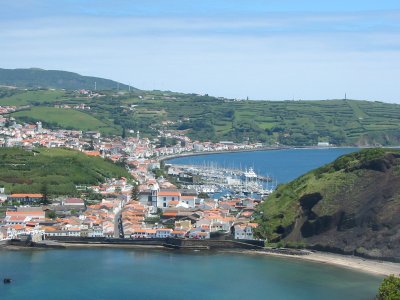 The Azores were uninhabited with no human traces
until Henry the Navigator claimed them for Portugal in the 15th Century.
Early settlers were quick to realise how fertile the land was and farming is
still a huge industry here. This is the view from the Monte da Guia
looking down over Horta and the marina. The local produce is excellent and
cheap, we bought 2kilos of cherries for just 5 Euros, fresh lettuce is
35cents. The cheese, milk, yoghurt and butter is all made in the
islands. We've loaded the boat up as much as we can. After the
expense of Bermuda this is a very welcome change.
 Looking the other way from the Monte da Guia, with
Penny, John and Nina.
 To the north east there's evidence of the island's
volcanic past, this is a crater that's now part of the coastline.
 Until 20 years ago, sperm whales were hunted with
hand harpoons from lighweight open rowing boats.
 It was Ems' from Blase birthday on the 14th
June. Here we are with along with the crew of Temula B at a resturant
where you cook your own food on a hot rock.
 The restaurant made a fabulous cake for Ems.
We were all eating it for days afterwards.
 Caroline, who's with us for the last passage to
Falmouth, had arrived earlier in the day. She's brought a huge
selection of newspapers and magazines much to our delight. Eddie couldn't
be parted with his latest copy of the Dandy.
 We did take time off to be a bit patrotic, this is
the gang off to watch England v Trinidad and Tobago. It was only
during the match that we became aware of metatarsals..have we been away to
long??
 The next day we hired a car to
tour Faial. First stop was the pools cut into volanic rock at
Varadouro.
 Caroline was the only one brave enough to try the
chilly water. She clearly hasn't spent enough time in the
Caribbean.
 But she can recognise a Tamarisk. Here is the
crew of Tamarisk under a Tamarisk.
 This is the Ponta dos Capelinhos at the western tip
of the Faial. The cliff in the background was caused by a series of
earthquakes and eruptions in 1958 and 1959.
 The noise of the eruptions could be heard 130 miles
away in Flores. By the time the lava flows had stopped Faial was 2.5km
bigger.
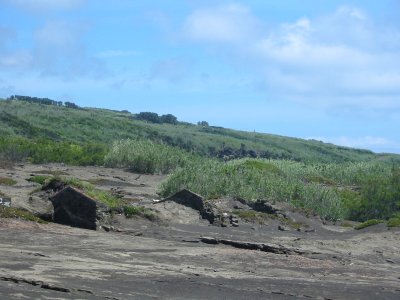 300 houses were buried by ash and pumice.
15,000 people, half the island's then population, left the island for
good.
 The old lighthouse, engulfed in ash up the second
storey windows, is now almost invisible from the sea. A new one has since
been built a little way up the coast.
 The new headland is about 160m high.
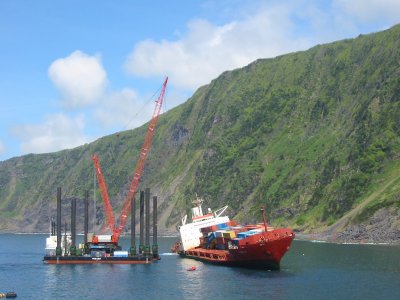 A more recent tourist attraction is the cargo ship
grounded six months ago on Praia de Faja, one of the island's best
beaches. The day we arrived a floating crane was being moved into position
by three tugs, ready to lift off the remaining containers.
 The centre of Faial is the
Caldeira, a volcanic crater 2km across and 400m deep. At
the edge is a tunnel, with a great view of Pico from one side.
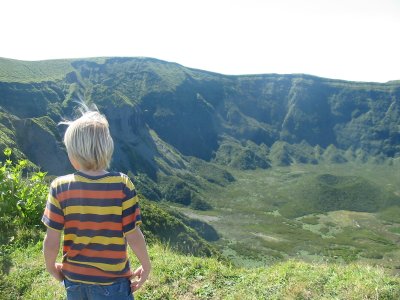 Here's Eddie looking down into the
crater. During the 1957/8 eruptions at Capelinhos fumaroles at the
centre began to steam and the lake partially drained away.
 This is the view towards Horta from
the Caldeira
 This was the end of a long day and children were
beginning to get a bit tired !!
We are now off to Terceira for a few days.
It's a twelve hour journey, which we plan to do overnight. We are hoping
to get their in time for a festival, and to see the Azorean version of bull
fighting. We're told they don't kill the animal but let them run through
the streets chased by a couple of men with ropes. After that the
current plan is to leave for Falmouth on Wednesday....as ever, weather
permitting.
|